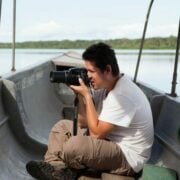I had been guiding treks around my hometown of Riobamba for about two years when the phone rang. “Want to climb Chimborazo with me?,” my mountaineering friend asked. The voice on the other end of the line was serious. “Chimborazo,” I thought, “that’s no joke.”
6,000 meters later and it didn’t feel like a joke, either. My legs and lungs burned as I stumbled up the icy summit, farther from the Earth’s core than any other human on the planet that day. Looking out over my home country, I knew the climb had changed my worldview.

Pros and Cons of climbing Chimborazo
Through a Fiery History, Chimborazo has Stood Strong
My hometown, Riobamba, is nestled right at Chimborazo’s feet, and the southern end of the Avenue of the Volcanoes—a 120-mile stretch of the Pan-American Highway that’s walled in by eight behemoth snow-capped volcanic cones. At 6,263 meters, Chimborazo is the highest peak in Ecuador and easily one of my favorites to climb.
In the annals of history, there has been some dispute: Is Mount Chimborazo taller than Everest? While not the tallest mountain above sea level, due to the Earth’s slight bulge at the equator it is the closest to the sun, about 2,160 m farther than Everest’s summit.
When I step outside and look up at it, I can’t help but think about what Chimborazo meant to those that came before me. To the indigenous Puruhá, the mountains were closely tied to the gods. To the hieleros, or “ice men,” hiking up to Chimborazo’s glaciers to harvest ice for sale at the market was a way of life. Locals harvested the ice for generations, but Baltazar Uscha, known as the last ice man, marks the end of this long tradition. To mountain guides like myself, climbing Chimborazo has always been a unique way of connecting to our world.
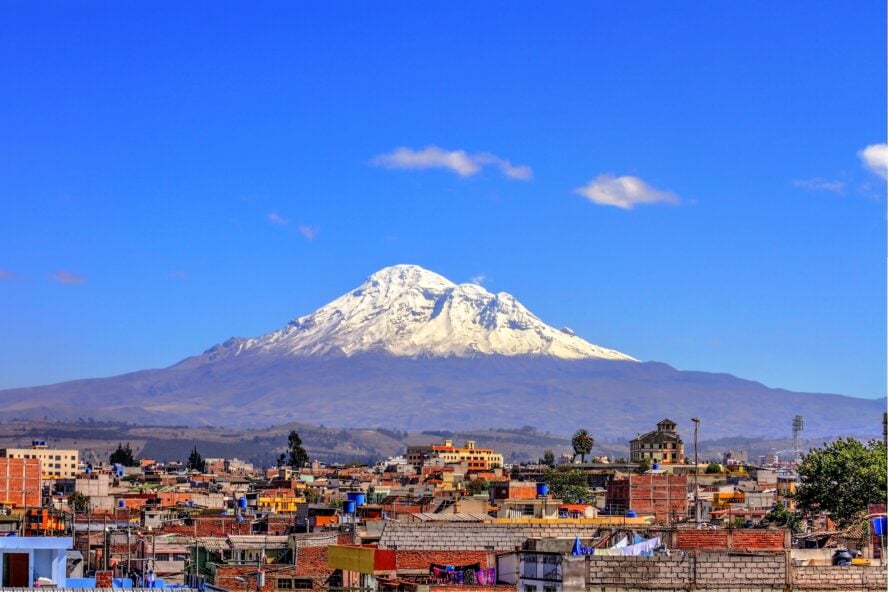
Climate change and what it means for Chimborazo
Chimborazo’s last eruption was more than 1,400 years ago, but as local temperatures increase the mountain is changing—if not so explosively these days.
Since the 1980s, Chimborazo’s glaciers have retreated up to six kilometers and the land has become arable higher on the slopes. Farmers must contend with the upward shift and unpredictable rainfall. The many ecosystems that call Chimborazo home are also affected, as plants and animals struggle to adapt.
To me, the biggest impact of the melting glaciers is the increased rock fall. Boulders that were once glued to Chimborazo’s face now increasingly hurl into the path of climbers and hikers. The threat has forced us to use alternate routes, while unexpected deaths from rockfall and avalanches become more common each year.
Climbing Chimborazo with a guide is more important now than ever before. I’ve seen and felt the change, so my goal through Ecuador Eco Adventures is to make summiting this beautiful mountain as safe and enjoyable as possible.
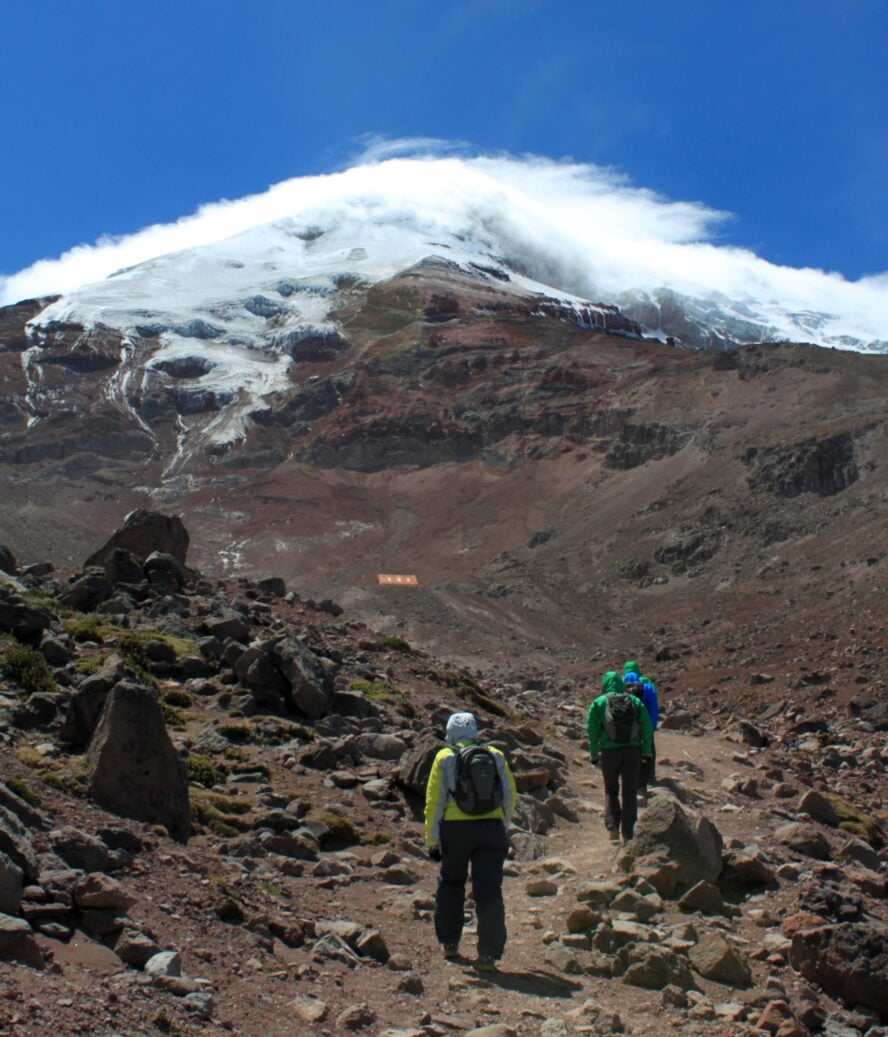
What to Know Before Climbing Chimborazo
Hiking above the clouds is no easy task
When I first climbed to 6,000 meters, the thin air took my breath away. I had spent the past two years guiding around Riobamba—more than 3,000 meters lower—and phew! I felt every step I took.
Despite being considered a “fast summit” for a 6,000 m peak (ascents are typically made in under 24 hours), its steep seas of glaciers, fields of rock and volatile weather mean you’re always moving. As such, physical fitness and previous mountaineering experience go a long way.
However, there’s no substitute for proper acclimatization. Accessible, gradual acclimatizing options include lower elevation climbs like Cotopaxi or Illiniza, and overnight stays in high mountain lodges.
The weather can change on a dime
An important part of climbing Chimborazo is adapting to the weather. Most tourists don’t really understand the Ecuadorian weather and, to be honest, neither do we. You can bathe in the sun all day and go to bed beneath a clear sky, yet still wake up in a blizzard. You’ll encounter snow or thunderstorms about 15% of the year, with March and April being the rainier months, but there really aren’t any seasons to hinge your plans on. Many decisions come down to weather, as our top priorities are to stay dry, warm, and most importantly safe.
A Two-Day Affair
For such a challenging climb, the expedition is surprisingly short. It all starts in Riobamba. After an extensive gear check, an 11:00 AM start brings us to the foot of the mountain by early afternoon. The familiar excitement contends with anticipation as Chimborazo nears.
We begin our journey at 4,800 meters. Often shrouded by mist, the vast field of red and gray stones that unfurls into the distance feels like another planet. I can’t see Chimborazo’s summit from here, but I can certainly feel its presence.
The journey through rock and ice
After about two hours of trail hiking, the 5,300 meter high camp welcomes us. An early dinner, comfy bed, and warmth of good company are short lived. At 12:00 AM in the low light of headlamps, we strap on crampons, zip up layers and step outside. There’s nearly 1,000 meters of steep climbing on a glacier with ever-thinning air between us and the summit. The goal is to reach the top by sunrise, between 6:00 and 7:30 AM.
It’s approximately 4 kilometers to Chimborazo’s highest point, the Whymper Summit. The climbing is sustained, and we strain at the higher elevations. Slowly, the mix of rock and snow turns to snow and ice. Our crampons dig in, clanging on rocks and sticking like magnets to the frozen ground.
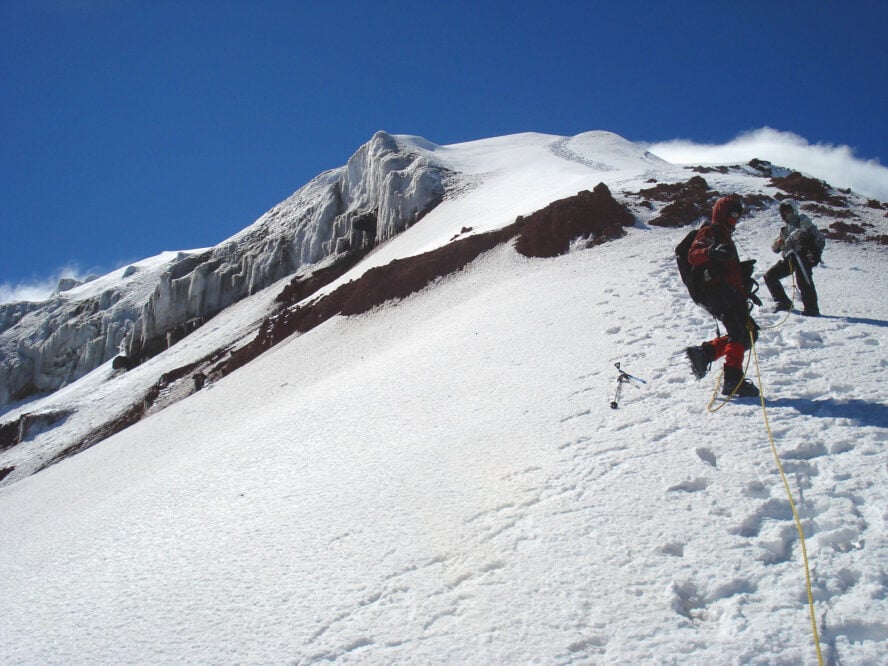
As the morning begins to thaw, the landscape around us comes alive. Rocks peek out of white mounds, the perfectly rounded summit looms over us. It seems within reach, but we hit a hard stop 30 meters from the top.
At the mountain’s mercy
We’ve arrived at the Veintimilla Summit, a critical checkpoint. It’s not far from the Whymper Summit, but the next few meters will decide our fate. At this point, lagging behind just a tiny bit can break the last leg of the trip.
As the rising sun begins to warm the air, softening snow increases avalanche potential. If we’re on time and the ground is solid, it’s up and away. If not, it’s time to turn back.
Before we know it, we’re standing on the summit of the highest mountain in Ecuador, the farthest place from the Earth’s center. Overcome with a sense of accomplishment, summiting Chimborazo is a high that will last for days. It’s hard to believe that just yesterday we were sitting at home in Riobamba, and by 2:00 PM we’ll be back again.
Why climbing Chimborazo is worth the challenge
Despite its imperfections—the fitful weather, sustained climbing, and overall challenge—
Chimborazo is one of my favorite climbs. From when you arrive in Riobamba and look up at Chimborazo for the first time, you can be up at its peak in just 48 hours, watching the sun rise and the remaining stars slowly fade away.
In my opinion, there is no better reward for a tough summit push than the views from Chimborazo’s peak. The Andes look like a sea of rolling, brown and green waves that crest into snow-capped peaks like Cotopaxi and Tungurahua. On a super clear day, you can see the ocean.
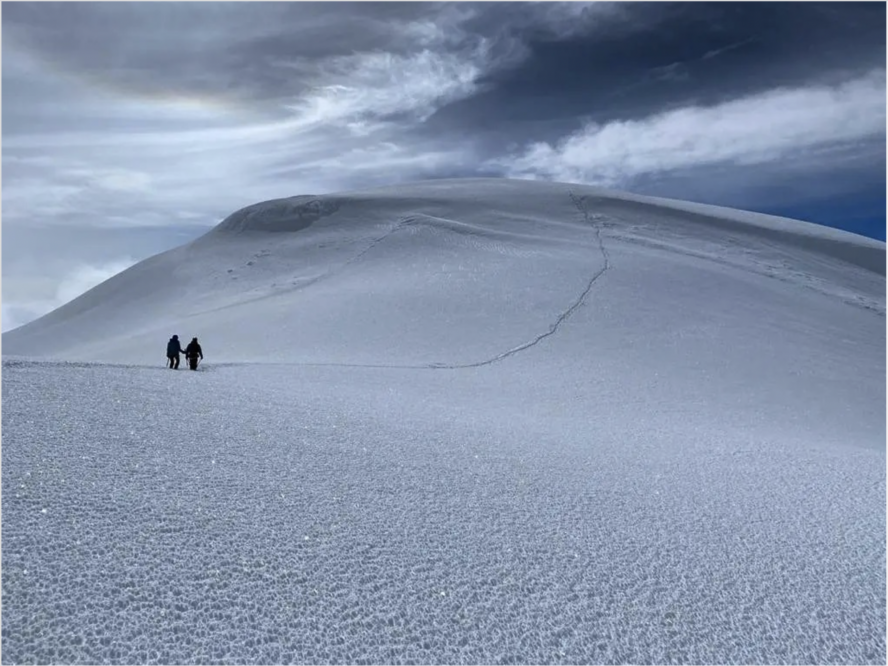
Is Chimborazo difficult or dangerous to climb?
Climbing Chimborazo is a serious feat, and should never be taken lightly. Crampons, ice axes, ropes, helmets, and proper clothing are all essential for the climb, so make sure you are prepared. When done correctly this can be a life-changing experience, but ignoring the conditions, heading out without a guide, and being unprepared can lead to potentially life-threatening situations—like avalanches and rock slides.
Deaths occur every year, and as climate change worsens the mountain becomes more unpredictable. So, head out with an Ecuadorian climbing guide (which the law requires) and make climbing safer for yourself and those around you.
How to prepare for a climb in the Andes
Before climbing any mountain, you have to prepare. For Chimborazo, this means learning the logistics, being fit enough for sustained climbing with a pack, acclimatizing to the elevation, getting familiar with the gear you’ll be using, and adapting to changing conditions. If you’re in good shape, getting ready for the climb can take less than a week, but it’s best to follow your guide’s advice and recommendations.
For non-Ecuadorian climbers, it’s required by law for a permitted guide to accompany you on the taller peaks. There is objective danger from rockfalls and because we make the summit push in the early hours, route-finding can be a challenge. Our main goal is to have a safe and successful climb, and from years of experience we know just how to make that happen.
Don’t plan on buying any layers once you land
Due to Ecuador’s high import tax rate, any gear made overseas is heavily marked up in price. To avoid paying a premium, the best thing you can do is to pack well. Buy the jackets, pants, base layers, and everything else you need beforehand and bring it with you. As for tools and safety equipment, let us handle those.
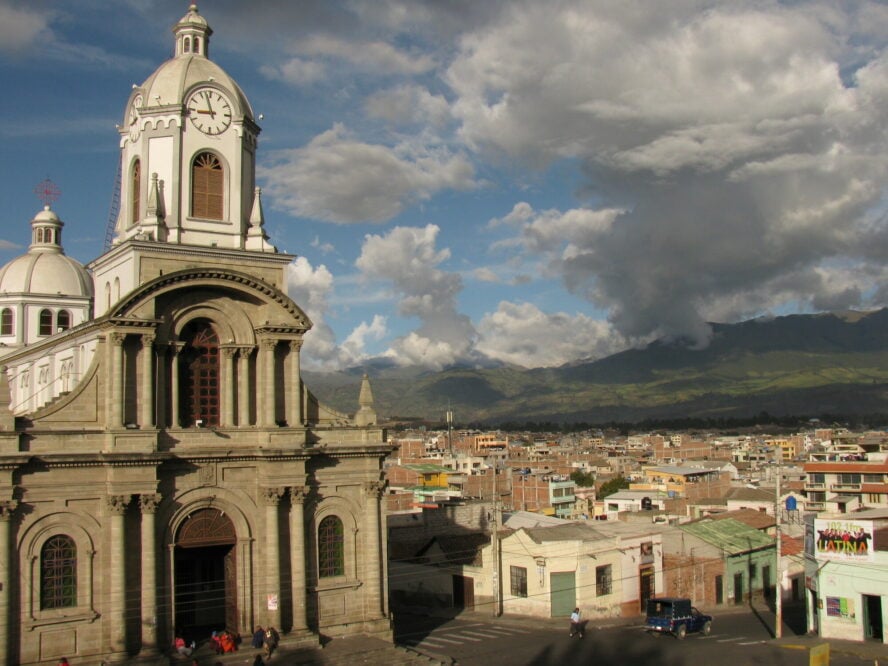
Riobamba is the sultan of the Andes, the heart of the homeland, and much more than just a climbing destination
Riobamba is home to some of the best traditional Ecuadorian food that you will find anywhere. Unlike restaurants in other countries, most places in Ecuador will specialize in just one thing, like grilled meats, stews, or sandwiches. These will have the very best traditional dishes, but for an all-around meal to fill me up I go to Viento del Oeste. This is a great spot on any day, but after a harrowing summit it is so much better.
Aside from food, there’s a lot of local culture to experience, like visiting the local alpaca wool producers, going on an excursion with the hieleros, walking around the street markets, and much much more.
If it’s outdoor sports you’re after, stick around Riobamba or see what our neighboring countries have to offer. Chimborazo’s base offers tons of great mountain biking and hiking, and there’s a lot more to explore along the Avenue of the Volcanoes, including climbing Cotopaxi. After a short flight south to Peru, you could even find yourself hiking the Inca Trail to Machu Picchu, or tackling the classic Santa Cruz Trek in the Cordillera Blanca. In my experience, there’s no better way to experience the stunning Andes than up close, on foot.
Undoubtedly tough but surprisingly quick, the expedition up Chimborazo isn’t one you’ll forget. I’ve called this mountain and Riobamba home for most of my life, and as a guide I want to share what makes it special with you too. If you’re looking for a summit to add to the list for the winter, spring, summer, or fall, consider Chimborazo.

